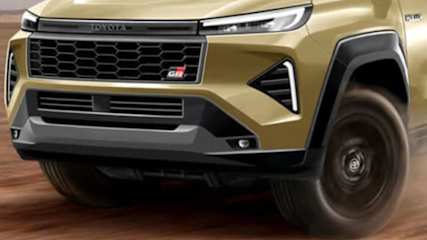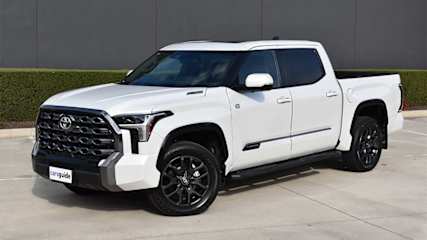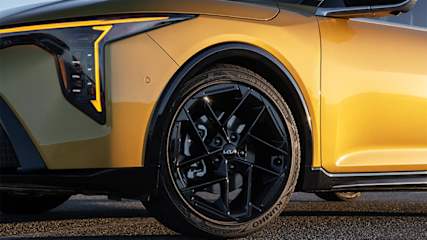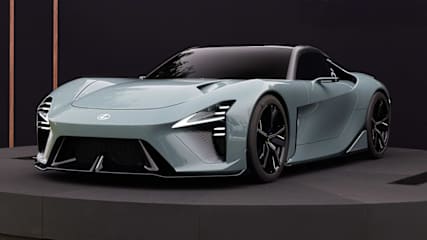1978 Toyota Stout Reviews
You'll find all our 1978 Toyota Stout reviews right here. 1978 Toyota Stout prices range from $2,640 for the Stout to $4,070 for the Stout .
Our reviews offer detailed analysis of the 's features, design, practicality, fuel consumption, engine and transmission, safety, ownership and what it's like to drive.
The most recent reviews sit up the top of the page, but if you're looking for an older model year or shopping for a used car, scroll down to find Toyota dating back as far as 1970.
Or, if you just want to read the latest news about the Toyota Stout, you'll find it all here.
Toyota Reviews and News

Top-selling Toyota updated for Australia
Read the article
By Jack Quick · 28 Aug 2025
Toyota has subtly updated its top-selling HiAce commercial van in Australia ahead of deliveries commencing in late August.

China's updated Prado rival gets cool spy tech: 2026 GWM Tank 500 updated in China and now comes with thermal imaging and 'Coffee' software
Read the article
By Laura Berry · 27 Aug 2025
GWM has upgraded the Tank 500 yet again.A new Smart Edition is now available in China bringing more advanced safety systems and luxury touches such as an on-board fridge and James Bond-esque thermal imaging, to the full size SUV.The Tank 500 Smart Edition brings GWM’s new advanced driver safety and navigation system Coffee Pilot Ultra, which uses a roof-mounted LiDAR system along with cameras fitted to the vehicle’s rear spoiler and side panels. A night vision thermal camera image shown in the instrument cluster also provides better visibility of pedestrians and wildlife on dark roads.The Smart Edition also showcases GWM’s new entertainment software — Coffee OS3 — promising faster processing and better graphics for the existing 14.6-inch central media screen and rear passenger display.Luxury touches coming on the Smart Edition include a 50W fridge in the centre console armrest, which can now keep items cool to -6C. The new edition also brings updated exterior styling to the Tank 500 including the brand’s new grille, redesigned headlights, fixed sidesteps and a new green body colour.The new Tank 500 Smart Edition launched in China this week, and CarsGuide has reached out to GWM Australia to confirm its arrival locally.The current Australian GWM Tank 500 range has three grades: the Lux Hybrid, Ultra Hybrid and Vanta Hybrid with prices starting at $66,490 driveaway.The Tank 500 is a petrol-electric hybrid vehicle and it's also a capable off-roader with a ladder frame chassis and four-wheel drive making it a rival to the Toyota Prado for budget conscious buyers.In Australia the Tank 500 is offered with one powertrain — a petrol-electric hybrid combining a 2.0-litre turbo-petrol engine with an electric motor making a combined 255kW and 648Nm.Since the vehicle launched in Australia in 2024 the Tank 500 has undergone a host of upgrades to suspension, driver safety alert systems and exterior design.Australian sales of the Tank 500 this year have lagged behind its smaller Tank 300 stablemate. GWM has sold a total of 894 Tank 500s (until the start of August this year) compared to the 2810 for the Tank 300.

New 2026 Toyota HiLux exposed: Long awaited rival to the Ford Ranger, Isuzu D-Max and BYD Shark 6 surfaces in new spy shots
Read the article
By Dom Tripolone · 26 Aug 2025
The new Toyota HiLux is getting close.

Toyota Tundra 2026 review: Platinum - GVM test
Read the article
By Mark Oastler · 25 Aug 2025
The Tundra full-size pick-up was launched in its native USA a quarter of a century ago, yet it's taken that long for the big American to finally be available in Aussie Toyota showrooms. So, has the much anticipated right-hand-drive version been worth the wait?
.jpg)
Secret to China's success exposed by new report ranking the best and worst: Chinese car companies such as Nio and Xiaomi leaving Nissan, Mazda Toyota behind in tech
Read the article
By Laura Berry · 25 Aug 2025
New Chinese carmakers such as Xiaomi, Xpeng and Nio are leaving established manufacturers such as Toyota, Nissan and Mazda behind when it comes to technology a new report has found, leaving doubts about whether the traditional players can ever catch up.

Toyota is the coolest car company in the world for petrolheads: How the world’s most boring brand had a stunning glow-up with the 2026 Toyota Yaris GR, Corolla GR, coming new Celica, MR2 and next-gen GR86 and GR Supra leading the charge | Opinion
Read the article
By Stephen Ottley · 25 Aug 2025
The recent news that Toyota Australia is discontinuing the GR Supra was sad for lovers of performance cars. But if you think that means Toyota is reverting back to its boring days of making ‘whitegoods on wheels’ then you are deeply mistaken.In fact, this is arguably the start of a golden age for not only Toyota as a brand, but the entire performance car market. Not only will the GR Supra be replaced by an all-new generation model, it is expected to be joined by a new Celica and possibly a revived MR2, if the rumours are true.And when I say ‘rumours’ I really mean teasers that Toyota itself has deliberately sent out into the world. In late 2024 it released an episode of its animated YouTube series, Grip, which featured a list consisting of: ‘Supra Mk6’, ‘Celica Mk8’, ‘MR2 Mk4’, ‘GR86 Mk3’ and ‘GR GT3’. Given Grip is an animated show and thought must be put into every element of the frame, those names didn’t appear by accident, but rather by design.Bringing back all of the brand’s iconic performance cars, which would join the existing GR Yaris and GR Corolla hot hatches in an expansive line-up of hero models would be something truly remarkable for petrolheads around the world.On top of this, Lexus just showed off a new sports car concept at the Monterey Car Week. This new rear-wheel drive coupe is expected to replace both the RC and LC coupes, form the basis of a new GT3 racing car and could even be V8 powered. If that all turns out to be true, it will be yet another major boost for the wider Toyota group’s coolness factor.It’s all part of a wider, all-encompassing strategy that Toyota began over a decade ago, with the launch of the revived 86 in 2012. This was a massive statement vehicle from the company, offering a rear-wheel drive coupe for under $30k, and a good one too, made a major impact on the perception of Toyota as a brand.The next most important model after the 86 to the brand’s current state of cool is the 2015 Toyota Prius. That was the first model to utilise the so-called Toyota New Generation Architecture or TNGA as it is more commonly known. Unlike the famous Volkswagen ‘MQB’ architecture, which was a modular platform able to be scaled up and down for a multitude of models, TNGA was broader than that. Yes, it was a scalable platform, but it spawned multiple platforms (TNGA-B, TNGA-F, etc) and it also represented a philosophical shift for the company.Under the leadership of Akio Toyoda, grandson of the company’s founder, this automotive behemoth made a conscious decision it was not going to be boring anymore. It decided that, even though it was incredibly successful, it should make a major change and not just make dependable, good value cars, but rather dependable, good value cars that are enjoyable to drive.This spurred the expansion of Gazoo Racing from Toyoda’s personal motorsport team to a global performance sub-brand that now offers multiple models with more clearly on the way. If all the speculation is right and Toyota rolls out a new Celica and MR2, alongside the new Supra, it will position the Japanese giant as arguably the most performance car heavy brand in the world.Which would be a remarkable turn around for a car maker that was once the subject of mockery from driving enthusiasts. Instead your future Toyota showroom has the potential to become a one-stop shop for car lovers looking for performance in any size and shape.

Take that China! 2026 Kia K4 hatch to hit the small-car sweet spot against the MG5, Toyota Corolla, Mazda 3 and Hyundai i30 as Kia doubles down on affordability
Read the article
By Byron Mathioudakis · 22 Aug 2025
Kia has reiterated its focus on affordability in Australia, with the imminent K4 five-door hatchback to slot alongside the K4 sedan released earlier this year to help it fight off cut-price alternatives from China.Sourced from Mexico but designed for global markets including Europe, the Cerato hatch replacement may even start from under $30,000 (all prices are before on-road costs), matching the Hyundai i30 Sedan (from $29,000).But, even if the K4 Hatch goes slightly over that price, it would likely still undercut the best-selling Toyota Corolla Ascent Sport Hybrid (from $32,110), as well as the Mazda 3 Pure (from $31,310) and Hyundai i30 N-Line (from $36,000) hatchback equivalents.With the Picanto city car from $18,690 currently Australia’s cheapest new vehicle, as well as the Stonic S small crossover from $25,660, K4 Sedan from $30,590 and Seltos S from $30,750, the K4 Hatch should substantially boost Kia’s fortunes at the bottom end of the new-car market.Feeding into consumer preference for hatchbacks over sedans in the small car segment, the sharply-styled K4 five-door looks – and is – shorter, yet has a larger (and more practical) cargo area, at 530 litres versus the four-door’s 508L.Plus, as with many other models, the newcomer has undergone an Australian-road tuning program run by engineering specialist, Graeme Gambold, giving it a distinct advantage against many other small-car alternatives.According to Kia Australia product planning manager, Roland Rivero, Kia is committed to providing accessible small cars that Australian buyers want, especially as competitors abandon them for crossovers and SUVs.“Picanto not going anywhere anytime soon, and it remains our entry into the Kia brand. And we're pretty happy with what Picanto has done for us, and that's going to be around for a long, long time yet,” he told CarsGuide.“And as for K4 is not going anywhere either, and K4 is going to have a full life, and we've committed to the Mexican factory to do our respective share. So far so good.”While the sedan version has tripled the preceding Cerato hatch and sedan’s January to July sales this year compared to the same period last year with 3322 registrations, it will be the hatch that presents the most promising volume opportunity in Australia.“Obviously, we can't wait for the hatchback to come along,” Rivero admits. Because that's what the market appetite is for. What was the split that we had with Cerato hatch to sedan? I think it was, like, 65 per cent hatch, versus 35 per cent sedan… (Australia) is a hatch market.”Of course, it isn’t just benevolence driving Kia’s move to offer greater small-car choice, since it seeks to better-offset their smaller carbon footprint against the larger, thirstier and dirtier SUVs (as well as the Tasman ute), reducing the likelihood of coming New Vehicle Efficiency Standard (NVES) penalties.That’s why the K4 Hatch will switch to an Atkinson Cycle 2.0-litre four-cylinder petrol engine – as found in the current Seltos as well as the related i30 Sedan 2.0P – that is more efficient and emits, according to Rivero, some 30 per cent fewer emissions than the regular, 112kW/192Nm version found in the K4 Sedan. The trade-off is a slight loss of power and torque, at 110kW and 180Nm respectively.Given the Hatch is poised to be the K4 volume seller, that should help Kia’s bottom line in more ways than one.

Lexus LFR hiding in plain sight?
Read the article
By James Cleary · 19 Aug 2025
Lexus has used one of the world’s most high-profile automotive events to unveil what it is positioning as a “progressively styled, future-focused yet truly authentic sportscar”, with the clear potential to form the basis of the upcoming LFR, a successor to the brand’s iconic V10-powered LFA supercar.‘The Quail, a Motorsports Gathering’ is an exclusive cornerstone of Monterey Car Week, as the name implies, a week-long celebration of the motor car consisting of everything from casual cars & coffee-style meet-ups to high-end auctions and VIP-only concours events.The event is held at the Quail Lodge & Golf Club in Carmel on the central California coast and the sinister, sweeping two-door machine, said to “signal the way forward for Lexus design” was its surprise centrepiece.The new Lexus concept’s long nose and fat haunches point to a front engine rear-drive layout which aligns with what’s known of the Lexus LFR, the likely LFA successor.Pre-production LFR prototypes have been snapped on the Spa-Francorchamps circuit within the last 12 months with reports out of Japan suggesting the hybrid V8-powered machine is a Lexus variation of 2022’s Toyota GR GT3 concept.In 2022 Toyota Racing Development President David Wilson confirmed a link between the GR GT3 and a future Lexus model and later that year images leaked from an apparent Lexus dealer conference in the US showed a Toyota GR GT3 silhouette with a Lexus badge and no rear wing.Japanese publication BestCar has referenced its usually reliable industry sources backing up the adoption of a front-mounted hybrid 4.0-litre, twin-turbo V8 engine driving the LFR’s rear wheels, the engine alone expected to produce 530kW with total output of around 660kW (885hp).This compares to the 420kW/480Nm produced by the LFA’s screaming 4.8-litre, naturally aspirated, Yamaha-developed V10 boasting a rev ceiling of 9000rpm.Just 500 LFAs were produced between 2010 and 2012 (plus 64 'Nurburgring Package' examples) but the LFR is expected to be a no-limit full-production model.Lexus is staying tight-lipped on any technical details relating to its latest concept, saying simply, “This inspiring concept car features a wide, low-profile two-door form that blends dynamic and emotional elements into a vision for a next-generation sports car.”Is this the 2026 Lexus LFR hiding in plain sight? Stay tuned…

Toyota axes cult favourite
Read the article
By Dom Tripolone · 18 Aug 2025
Toyota has sunk its flagship sports car in Australia.
.jpg)
Kia Tasman's next move exposed: The 2026 Kia Tasman ute’s next step against the Ford Ranger, BYD Shark 6 and Toyota HiLux to be hybrid power
Read the article
By Byron Mathioudakis · 12 Aug 2025
Where does the Kia Tasman go from here?
Is having a conventional diesel engine as the sole choice enough to run with the best-sellers?
Should the Tasman follow the lead of the Ranger Raptor by going down the off-road performance path, to create a halo model for the rest of the range to bask beneath?
Or is going hybrid the answer?
The answer may shock you!




